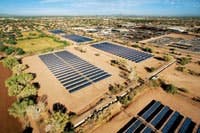With wastewater charges to residential customers increasing more than 14% over the past few years, the opportunity exists for wastewater facilities to come up with creative solutions to control costs and level fees for their customers.
One idea with immediate impact is to find solutions for managing the largest controllable cost: energy. With the nation’s wastewater plants and drinking water systems spending almost $4 billion per year on energy to treat water—which can add up to one-third of a municipality’s total energy bill—solutions for controlling energy costs become even more relevant.
The Solar Opportunity
The Neely Wastewater Reclamation Facility (WRF) in Gilbert, Ariz., has taken an innovative approach to leveling energy costs by housing one of the country’s first solar photovoltaic (PV) power systems installed above operating recharge basins. In collaboration with its project partners, the WRF designed an elevated 2.3-MW DC solar power system built directly in operating recharge basins to maximize land space. The basins are flooded for groundwater percolation and aquifer replenishment. The ground-mount solar power system tracks the sun, further increasing solar production on the facility’s available space and improving investment returns.
“The opportunity to create a multipurpose usage for the groundwater recharge basins—using them for both aquifer replenishment and as a platform for solar energy generation—was compelling,” said Mark Horn, manager of Neely WRF. “What was even more compelling was the energy cost saving potential and [the fact that] SPG Solar would provide the maintenance and assurance of minimal downtime for the system.”
The solar power system provides the equivalent of up to 40% of the plant’s energy needs, with an expected savings of up to $2 million in energy costs over the next 20 years. In addition, there were no upfront capital costs to the municipality because the solar project was financed through a power purchase agreement (PPA).
“We structured the PPA so that the town of Gilbert would not have to put in any of its own capital and the taxpayers would not be saddled with the costs,” said Michael Johnson, vice president of structured finance for SPG Solar. “This made it an afford- able and popular solution that showcases Gilbert’s commitment to sustainability and fiscal foresight in controlling energy costs over the long term.”
The PPA allows the town of Gilbert to pay for the electricity the solar PV panels generate at a fixed rate for 20 years. Through the additional support of incentives from Arizona Public Services, Gilbert is securing its future and stabilizing its budget by hedging against rising electricity utility rates, which are expected to increase at an average of 4% annually in the state.
Doubling Up On Land
The Neely WRF currently produces approximately 7 million gal of reclaimed water per day, some of which is introduced into recharge basins where groundwater percolation and aquifer replenishment occur. The reclaimed water then is reused beneficially throughout the community for irrigation, wetland creation and other non-potable water applications. The Neely Recharge Facility, where solar power system is constructed, is directly adjacent to the Neely WRF.
With most of the Neely WRF's acreage already in use, SPG Solar designed a one-of-a-kind elevated solar power system in five of the 11 basins at the adjacent Neely Recharge Facility. More than 8,000 solar PV panels were installed on a tracking system generating more than 4 million kWh of electricity annually—equivalent to producing enough electricity to power more than 440 average American homes for one year.
Engineering Challenges
The principle challenge was to design a system that was elevated to allow for a minimum clearance of 6.5 ft under the solar panels when in stow—the neutral horizontal position. The height clearance was required to allow space for the water recharge operation below the panels, as well as for the low-profile maintenance equipment used to maintain the recharge basins.
An elevated system was designed and, as part of the engineering solution, the SunSeeker Tracker system was selected to increase solar power production by up to 20% over a fixed-tilt system. By programming the solar panels to follow the sun through the course of the day, tracking east to west, more power is generated per acre.
The increased height requirement combined with the expanding and contracting soil in the basins entailed special engineering of the sup- port pilings, which were driven nearly 13 ft below ground level. To ensure stability and a robust system, reinforced concrete was introduced into the top 6 ft of the below-grade pilings, creating a “hybrid” foundation solution.
The Impact
The solar power system is an important step toward Gilbert’s goal of a “clean, safe and vibrant” community for its residents—as well as a way to control its operating costs and manage its budgets. The project was designed and constructed without any capital cost contribution required of Gilbert, and all ongoing operations and maintenance are covered by SPG Solar. The system will produce the equivalent of up to 40% of the Neely WRF’s power needs, providing a reliable source of energy and protecting ratepayers against rising electricity costs—all without taking up land space at the wastewater facility or interrupting facility operations.
Download: Here


